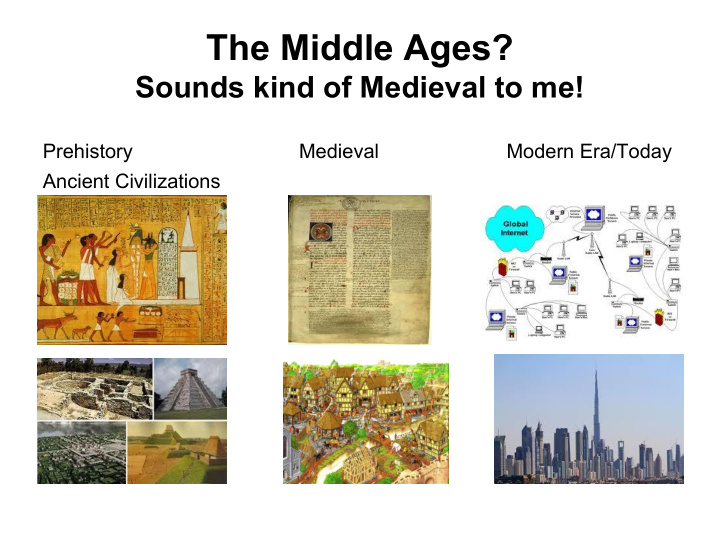



The Middle Ages? Sounds kind of Medieval to me! Prehistory Medieval Modern Era/Today Ancient Civilizations
What is the Medieval period? ● After the collapse of Rome, Western Europe entered a period of political, social, and economic decline. ● From about 500 ce to 1000 ce , it was politically divided, rural, and largely cut off from advanced civilizations in the Middle East, China, and India. ● Waves of invaders swept across the region, trade slowed to a trickle, towns emptied , and classical learning virtually ceased .
What is the Medieval period? ● For those reasons, this period in Europe has sometimes been called the Dark Ages . ● Greco-Roman, Germanic, and Christian traditions slowly blended, creating a Medieval Culture.
What are some characteristics of the Middle Ages culture? ● They were mostly farmers and herders , so they had no cities or written laws. ● Instead, they lived in small communities governed by unwritten customs . (Manorialism) ● Warriors swore loyalty to the king in exchange for weapons and a share in the plunder taken from conquered people. (Feudalism ) Many small Feudal armies – constant warfare
Characteristics continued... ● Feudal Kingdoms (small decentralized /Totalitarian) ● Arbitrary Law (Trial by ordeal) ● Rural Life (isolated, conservative, homogenous country living) ● Education not valued –Germanic societies were illiterate – no written language
Characteristics continued... ● Tribal relationships- Individually different yet they share - Common values, languages, customs – ● Believe they share a mythical or common ancestor) Warrior tradition – social order was to develop Kingships/Kingdoms – ● The “Church” remains as the one constant from the Roman Empire into and throughout the Medieval Period. ● Church authority grew more powerful
Who caused the fall of the Roman Empire that created the Medieval culture? Germanic Tribes, Barbarians, Northern Invaders (Vandals, Visigoths, Vikings, Saxons, Franks, Ostrogoths)
Who were the people that made up Medieval culture? Church Officials/Clergy : Pope, Cardinals, Bishops, Monks, Nuns, Priests, Friars Upper class/Nobility/Landowners : Monarchs, Kings, Prince, Princess, Dukes, Earls, Duchesses, Knights
Who were the people that made up Medieval culture? ● Middle Class : Merchants, Educators, Traders, Artisans ● Lower Class : Peasants and Serfs made up about 80% of the population.
When were the Middle Ages? The period between ancient times and modern times…roughly from 500 ● ce to 1500 ce —is called the Middle Ages . ● It is also called the Medieval period… from the Latin words for “middle age.”
Where did the “Middle Ages” take place? ● Europe...Northern Africa ...Middle East ● The Former Roman Empire (Eastern and Western Empire) and the territories on its fringes.
Why did Medieval culture evolve after the fall of the Roman Empire? Greco-Roman, Germanic, and Christian traditions slowly blended (assimilation/acculturation), creating a Medieval Culture.
How did Europe begin to grow out of the “Dark Ages”? ● Increase in Trade both internally (within Europe) and externally (outside Europe:Africa, Middle East and India). ● Returning Crusaders brought ideas, goods and knowledge from the Middle East (Arabic ) and India.
● Church Influence began to decline...allowing for more freedom of thought. ● Rebirth of Greco-Roman values (individualism,logic) and Traditions. ● Creation of a “ Middle Class ” who valued education and lived in cities .
Why was the middle class growing? Changes in Europe from 1000 ce to 1500 ce set the foundation for individual and economic prosperity. ● Increase in trade. ● Rise in population leads to less need for serfs ● More people moving to cities ● Increase in Education ● Increase in Individualism
Why did the Church lose power near the end of the Middle Ages? Failure of Crusade s weakened belief in the church as decision makers and leaders. Loss of many devout nobles left less devout (more political) nobles in power . The strength of these Nobles increased and the creation of Nation states began under their leadership New ideas from around the region (increase in trade) and increase in education (middle class value) lead to people questioning church teachings. ● The world is round not flat ● The Sun is the center of the Universe not the Earth ● Logic and reason replace church dogma Church corruption (selling of indulgences, torture and suppression of new ideas)lead to divisions within the church eventually leading to the Reformation in 1512. (division of Christian church into Catholic and Protestant)
Wisdom: Results/Solutions Events of The Middle Ages such as the rise of the middle class and the decline in church authority lead to a western world that would see: The Division of the Christian church into Protestant and Catholic ( Protestant Revolution ) A renewed interest in Science, Mathematics, Logic and Reason that will lead to a new consciousness for Europeans ( Renaissance/The Scientific Revolution ) The rise of Individualism and more freedoms and liberties across the socioeconomic spectrum ( Renaissance ) Any guesses about what Unit 3 will cover?
Recommend
More recommend